Geochemical Monitoring Automatic Systems Laboratory
- Home
- Instruments and Personnel
- Projects and Scientific Interests
- Publications
- Methods and Applications

The study of earthquake precursory phenomena is attracting the interest of the scientific community since long time (Wakita et al., 1975; King, 1986, 1989; Thomas, 1988). The development of geochemical monitoring methods and devices increased after the Tashkent (Uzbekistan) earthquake of 1966, that produced the first well documented Radon anomaly (Ulomov and Mavashev, 1967). Nevertheless, the problem of earthquake prediction is far from being solved and the usefulness of monitoring methods and devices currently in use is still matter of debate and object of active research (e.g Albarello, 2015; Biagi and Tramutoli, 2015). Independently from the methodological approach and the type of signal investigated, it is generally accepted that the collection of good quality data series, with a meaningful time coverage, is an essential step to drive to tangible results the research about precursors. The identification of pre-seismic patterns that do not conform to expected behavior (anomaly detection) and their validation through suitable data processing is a key aspect of the precursors analysis.
The geochemical monitoring operative protocol involves the concurrent measurement of different parameters to ensure cross-checking of independent signals.
Furthermore the geochemical parameters measured by the automatic stations should be informative of the chemical and physical processes possibly associated to the energy release and/or the permeability variations induced by seismogenic processes, i.e. i) variations in the concentration of gas compounds in soil gases and deep waters (He, Ar, Rn, H2, CO2, CH4, H2S), ii) mixing of waters of different origin, iii) changes in temperature, salinity, redox potential and/or other parameters (e.g., Scholz et al., 1973; Thomas, 1988; Muir-Wood and King, 1993; Rojstaczer et al., 1995; Roeloffs, 1998; Brodsky et al., 2003; Wang et al., 2004; Elkhoury et al., 2006; Wang and Chia, 2008; Doglioni et al., 2014).
The monitoring must be strictly continuous to ensure the capability to detect signal variations occurring over short time intervals. In fact, the variations of the concentration values of various substances, whether induced by environmental factors and/or seismic events, can last also a few hours. Therefore, the sampling time interval has to be adjusted according to the expected changes of the parameter value that we intend to identify. The monitoring must be extended over long periods of time to accurately and precisely define the background values of each monitored parameter.
According to these criteria, as a part of a seismic prevention/prediction program of the Regional Government of Tuscany, Since late 2002 the IGG – CNR has designed, built and installed in Tuscany (Italy) a continuous automatic monitoring network (the Geochemistry Network of Tuscany, thereinafter GNT).
The monitoring is aimed to investigate the geochemical response of selected aquifers to local seismic activity.
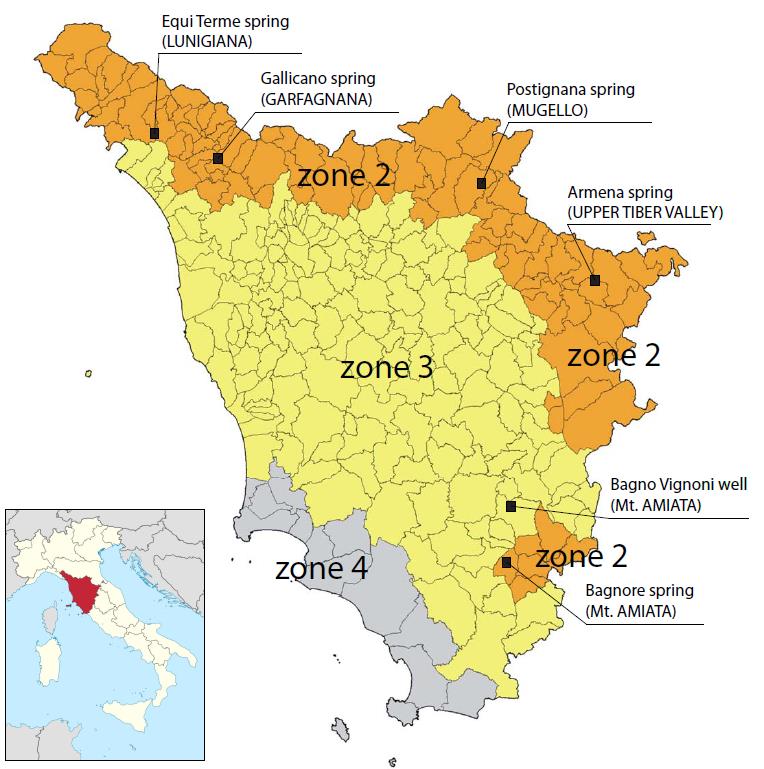
The network (Fig. 1) currently consists of six continuous automatic stations installed in the areas of highest seismic risk of Tuscany:
- Lunigiana (Equi Terme spring),
- Garfagnana (Capritz spring),
- Mugello (Postignana spring - Vicchio),
- Upper Tiber Valley (Armena spring – Caprese Michelangelo) and Mt. Amiata (Bagnore spring and Bagno Vignoni well).
All the stations are equipped with sensors for the measurement of temperature, pH, redox potential, electrical conductivity, CO2 and CH4 dissolved concentration.The setup of GNT has financially supported by the Regional Government of Tuscany, as a part of a seismic prevention/prediction program. Together with other monitoring networks of Tuscany (i.e. seismic, accelerometric and geodetic networks), the GNT is officially recognized by the Regional Government of Tuscany (Law n. 58 of 16 October 2009) as a ‘‘reference tool for the analysis and research on seismic risk’’.
INSTRUMENTS
The continuous automatic monitoring station.
The IGG-CNR-Pisa continuous automatic monitoring stations (Fig. 2) are equipped with sensors for the simultaneous measurement of temperature (T), pH, electrical conductivity (EC), redox potential (ORP) and dissolved content of CO2 and CH4. The measurement of CO2 and CH4 dissolved concentration is done with an extraction cell specifically designed and realized in the IGG-CNR-Pisa laboratories (Cioni et al, 2007). In the cell (Fig. 3), gas is equilibrated by flowing in the headspace above the water level inside the cell, in a closed loop which includes the I.R. spectrometers and a lowflow pump, which provides the necessary gas circulation in the loop.
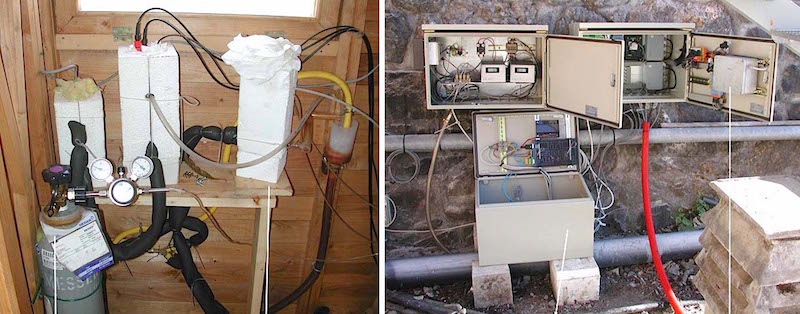
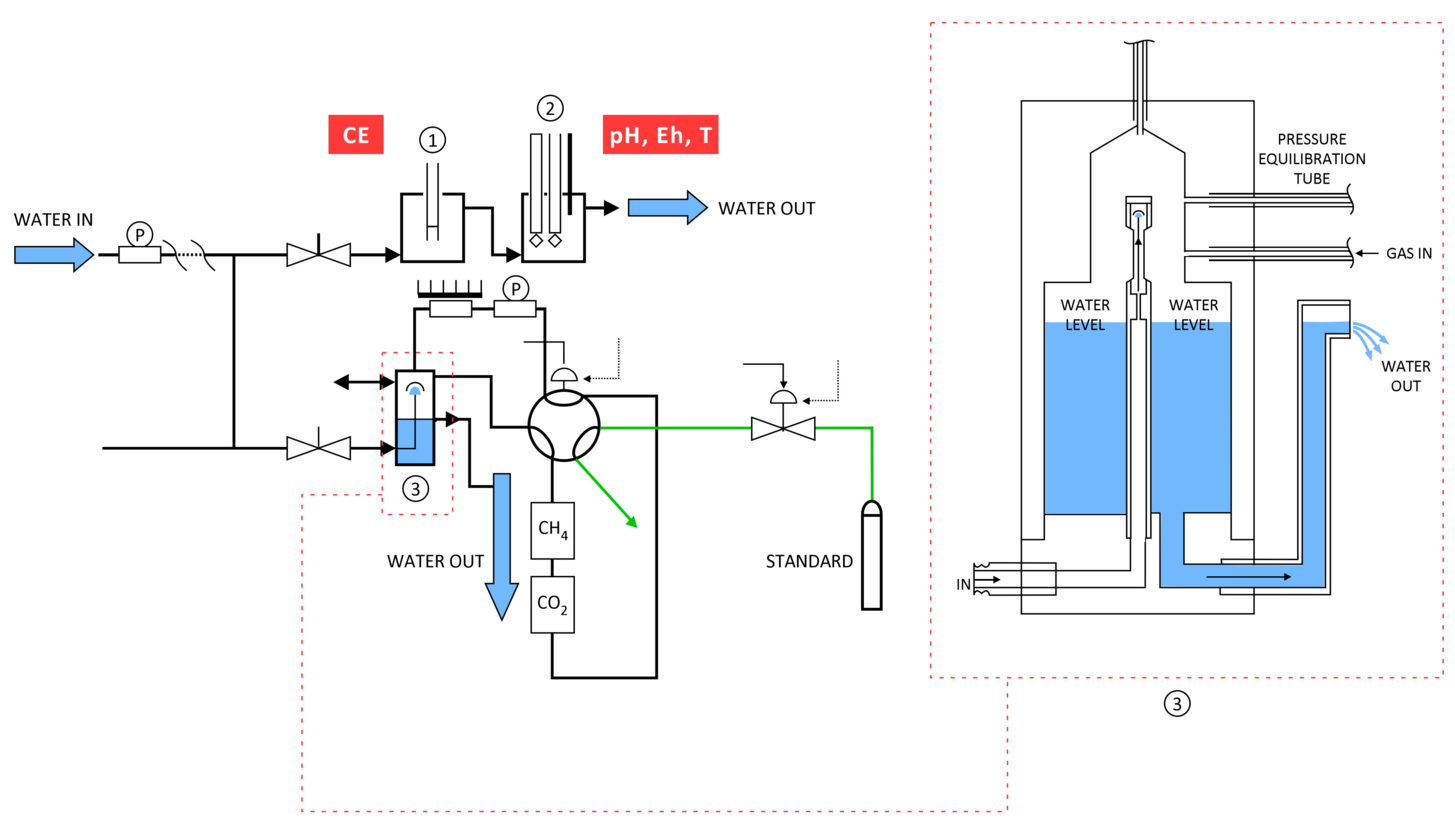
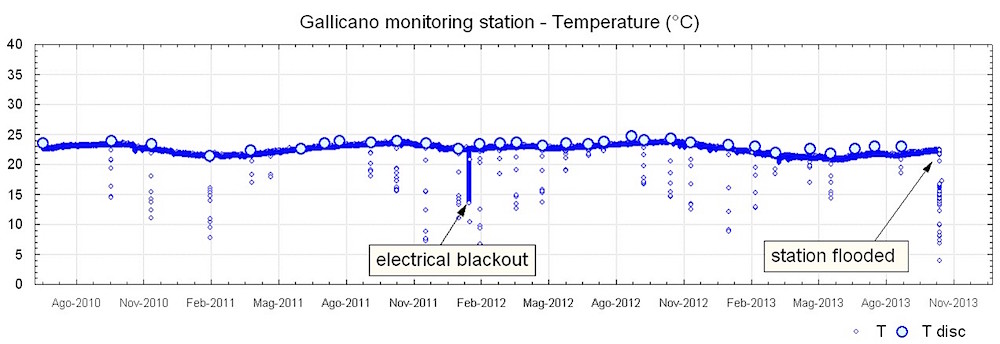
Data acquisition and transmission,
The stations operate with flowing water (about 5 litres per minute), and a frequency acquisition of 1 second for all the parameters. Average, median and variance of the data are calculated over a period of 5 min. The small sampling step ensures the capability to detect signal variations occurring over short time intervals.
In the Vicchio, Caprese Michelangelo and Bagnore stations data are recorded with an embedded computer. Data can be downloaded both onsite and in remote, via a GSM/GPRS modem connected to the embedded PC. In the Gallicano, Equi Terme and Bagno Vignoni stations, data are recorded with an in situ data logger and transmitted once a day to CNR–IGG elaboration centre, by router GPRS.
Each router connects to the mobile network via a M2M sim. The data loggers are programmed to send data to an FTP server located in the lab: every day (midnight) the data of the last 24 hours, are sent to the server in a .csv file (about 72 KB). In the lab it was set up a FTP server (with Linux operating system) that receives the daily data from the three stations.
The data automatically sent to the server are combined into a single file through a program specifically created.
It was also set up a PC in which the "Monitoring Stations" program (specially made in c #) has been installed. This program checks daily if stations have sent the files and otherwise sends a warning email.
STAFF
Lisa Pierotti Ph. D. (CNR Researcher - Head Laboratory)
Ing. Gianluca Facca (CNR Technician)
CONTACTS
Phone:
+39 050 6212325 (Office/Laboratory)
+39 338 6725807 (Lisa Pierotti)
+39 392 2091759 (Gianluca Facca)
E-mail:
Since 2002 the IGG Geochemical monitoring automatic systems Laboratory is actively involved in scientific projects:
- 2002 – 2004: “Realization of a geochemical monitoring network in Garfagnana and Lunigiana areas (Tuscany, Italy) to studying possible relationship between geochemical variations in waters and seismic activity”. Cooperation agreements with the Seismic Prevention Sector of Tuscany Region. Scientific coordinator of the research Dr. Roberto Cioni.
- 2002 – 2004: “Realization of a geochemical monitoring network in the Mt. Amiata area (Tuscany, Italy) to studying possible relationship between geochemical variations in waters and seismic activity”. Cooperation agreements with the Seismic Prevention Sector of Tuscany Region. Scientific coordinator of the research Dr. Roberto Cioni.
- 2010: “Continuation of activities about the acquisition, management, data processing concerning the geochemical monitoring network installed in the areas with the highest seismic risk of Tuscany”. Cooperation agreements with the Seismic Prevention Sector of Tuscany Region.Scientific coordinator of the research Dr. Roberto Cioni.
- 2011: “Continuation of activities about the acquisition, management, data processing concerning the geochemical monitoring network installed in the areas with the highest seismic risk of Tuscany”. Cooperation agreements with the Seismic Prevention Sector of Tuscany Region. Scientific coordinator of the research Dr. Lisa Pierotti.
- 2013: “Continuation of activities about the acquisition, management, data processing concerning the geochemical monitoring network installed in the areas with the highest seismic risk of Tuscany”. Cooperation agreements with the Seismic Prevention Sector of Tuscany Region. Scientific coordinator of the research Dr. Lisa Pierotti.
- 2013: “Convention for research related to the short-term prediction of earthquakes, INGV-DPC, project line S3”. Cooperation agreement with Regional Environmental Protection Agency, Emilia. Scientific coordinator of the research Dr. Lisa Pierotti.
- 2014: “Realization of the research described in the S3 Project - Short term forecast and earthquakes preparation, DPC-INGV 2012
- 2021”. Cooperation agreement with National Institute of Oceanography and Experimental Geophysics, Trieste. Scientific coordinator of the research Dr. Lisa Pierotti.
- 2015: “Continuation of activities about the acquisition, management, data processing concerning the geochemical monitoring network installed in the areas with the highest seismic risk of Tuscany”. Cooperation agreements with the Seismic Prevention Sector of Tuscany Region. Scientific coordinator of the research Dr. Lisa Pierotti.
- 2016: Elaboration of a scientific report on chemical and physico-chemical characteristics of the natural mineral waters of Equi Terme spring - Cooperation agreements with Cooperativa Terme e Valle del Lucido. Scientific coordinator of the research Dr. Lisa Pierotti.
- 2016: Geochemical and radiometric monitoring of the Gallicano (LU) thermomineral spring for the research on the seismic risk. Cooperation agreements with the Department of Civil and Industrial Engineering (Pisa University) and Gallicano municipality. Scientific coordinator of the research Dr. Lisa Pierotti.
- L. Pierotti, G. Cortecci, F. Gherardi (2016). Hydrothermal gases in a shallow aquifer at Mt. Amiata, Italy: insights from stable isotopes and geochemical modelling. Isotopes in environmental and health studies. http://dx.doi.org/10.1080/10256016.2015.1113958.
- L. Pierotti, F. Botti, V. DíIntinosante, G. Facca, F. Gherardi, (2015). Anomalous CO2 content in the Gallicano thermo-mineral spring (Serchio Valley, Italy) before the 21 June 2013, Alpi Apuane Earthquake (M = 5.2). Physics and Chemistry of the Earth, 85-86, 131 ñ 140.
- Martinelli G., Dadomo A., Heinicke J., Italiano F., Petrini R., Pierotti L., Riggio A., Santulin M., Slejko F.F., Tamaro A. (2015). Recovery and processing of hydrological and hydrogeochemical parameters for researches on earthquake short-term precursors in Italy. Bollettino di Geofisica Teorica ed Applicata Vol. 56, n. 2, pp. 115-128.
- Martinelli G., Bonfanti P., Dadomo A., Gentile F., Gherardi F., Italiano F., Pierotti L., Riggio A., Santulin M., Tamaro A. (2015). Monitoring of deep seated underground fluids within the frame of the DPC-INGV S3 Project (2nd year), 34∞ Convegno nazionale GNGTS, Trieste, 17 - 19 Novembre 2015.
- L. Pierotti, G. Cortecci, F. Gherardi (2015). Hydrothermal gases in a shallow aquifer at Mt. Amiata, Italy: Insights from stable isotopes and geochemical modelling. International Symposium on Isotope Hydrology. IAEA, Vienna 11-15 May, 2015.
- L. Pierotti, G. Facca, F. Gherardi. (2015). Cross-correlation analysis of 2012 - 2014 seismic events in Central - Northern Italy: insights from the geochemical monitoring network of Tuscany Geophysical Research Abstracts Vol. 17, EGU2015-11826-2, 2015 EGU General Assembly 2015, Vienna, 12 - 17 April 2015.
- G. Martinelli, A. Dadomo, M. Santulin, F. Gentile, A. Riggio, F. Italiano, P. Bonfanti, L. Pierotti, F. Gherardi (2015). Time-Space patterns of the hydrogeochemical observables representative of medium/short term variations of the crustal strain field in the study area (D.2). In: Project S3 Short term earthquake prediction and preparation. Project Directors: Dario Albarello, Università degli Studi di Siena, Cristiano Tolomei, Istituto Nazionale di Geofisica e Vulcanologia; DPC Representative: Roberta Giuliani; Coordinator of Seismological/Volcanological Programme Committee: Riccardo Caputo, Università degli Studi di Ferrara. Final Scientific Report June 30th, 2015.
- G. Martinelli, P. Bonfanti, A Dadomo, F. Gentile, F. Gherardi, F. Italiano, L. Pierotti, A. Riggio, M. Santulin, A. Tamaro (2014). Il progetto S3 ñ Previsione a medio termine dei terremoti. Monitoraggio dei fluidi di origine profonda, 33∞ Convegno nazionale GNGTS, Bologna, 25 - 27 Novembre 2014.
- L. Pierotti, G. Facca, F. Gherardi (2014). Anomalous CO2 content in the Gallicano thermomineral spring (Serchio Valley, Italy) before the 21 June, 2013 Alpi Apuane earthquake (M = 5.2), Geophysical Research Abstracts Vol. 16, EGU2014-14051, EGU General Assembly, Vienna 27 April ñ 02 May 2014.
- L.Pierotti, E.Calvi, G. Facca, F. Gherardi, S. TrifirÚ (2014). Il monitoraggio geochimico in Toscana. In: La pericolosità sismica della Regione Toscana, a cura del Servizio Prevenzione Sismica della Regione Toscana
http://www.rete.toscana.it/sett/pta/sismica/01informazione/formazione/pubblicazioni/microzonazione/index.htm - G. Martinelli, A. Riggio, A. Dadomo, F. Italiano, R. Petrini, L. Pierotti, M. Santulin, F. Slejko, A. Tamaro. (2013). D1.2 database of time series relative to hydrogeochemical and Radon observations. In DPC-INGV-S3 Project: ìShort Term Earthquake prediction and Preparationî Programme Coordinator: Riccardo Caputo Università di Ferrara, Programme Responsible: Giuseppe Di Capua Istituto Nazionale di Geofisica e Vulcanologia DPC-INGV-S3 Project ìShort term earthquake prediction and preparationî Final Report.
- L. Pierotti, F. Botti, S. Bracaloni, I. Burresi, M. Cattaneo, F. Gherardi (2013). Hydrogeochemistry of Magra Valley (Italy) aquifers: geochemical background of an area investigated for seismic precursors. Procedia Earth and Planetary Science 7, 697 ñ 700.
- L. Pierotti, G. Facca, F. Gherardi (2013). La rete geochimica toscana per lo studio dei precursori idrogeochimici dellíattività sismica. 32∞ Convegno nazionale GNGTS, Trieste, 19 - 21 Novembre 2013.
- L. Pierotti and G. Facca (2013). The continuous automatic monitoring in Tuscany (Italy) to identify possible hydrogeochemical precursors of earthquakes. Geoitalia 2013, Pisa 16-18 settembre 2013.
- L. Pierotti, G. Cortecci, G. Facca, F. Gherardi (2013). Anomalous CO2 contents in a shallow aquifer of the Mt.Amiata geothermal area, Italy. Goldschmidt 2013 Conference Abstracts, 1969.
- L. Pierotti and G. Facca (2012). Realization of a Geochemical Monitoring Network in Tuscany (Italy): possible application of hydrogeochemical precursors to the study of earthquakes. Euregeo, Bologna 12 - 15 Giugno 2012.
- L. Pierotti and R. Cioni (2010). The continuous automatic monitoring network installed in Tuscany (Italy) since late 2002, to study earthquake precursory phenomena. Geophysical Research Abstracts Vol. 12, EGU2010-11325, EGU General Assembly, Vienna 2 - 7 May 2010.
- R. Cioni, M. Guidi, L. Pierotti, and A. Scozzari (2007). An automatic monitoring network installed in Tuscany (Italy) for studying possible geochemical precursory phenomena. Nat. Hazards Earth Syst. Sci., 7, 405ñ416.
- F. Baldacci, F. Botti, R. Cioni, G. Molli, L. Pierotti, and A. Scozzari. (2007). Geological-structural and hydrogeochemical studies of sismically active structures: case history from the Equi Terme-Monzone area (Northern Apennine ñ Italy). Geoitalia, Rimini 12-14 Settembre 2007.
- F. Baldacci, F. Botti, R. Cioni, G. Molli, L. Pierotti, and A. Scozzari (2007). Hydrostructural and hydrothermal models for the studies of the hydrogeochemical precursors of the seismic activity Examples from ìSerchio and Magra grabensî (Northern Apennines, Italy). International Union of Geodesy and Geophysics, Perugia, 2-13 Luglio 2007.
- L. Pierotti, G. Cortecci, F. Gherardi (2016). Hydrothermal gases in a shallow aquifer at Mt. Amiata, Italy: insights from stable isotopes and geochemical modelling. Isotopes in environmental and health studies. http://dx.doi.org/10.1080/10256016.2015.1113958.
- L. Pierotti, F. Botti, V. DíIntinosante, G. Facca, F. Gherardi, (2015). Anomalous CO2 content in the Gallicano thermo-mineral spring (Serchio Valley, Italy) before the 21 June 2013, Alpi Apuane Earthquake (M = 5.2). Physics and Chemistry of the Earth, 85-86, 131 ñ 140.
- Martinelli G., Dadomo A., Heinicke J., Italiano F., Petrini R., Pierotti L., Riggio A., Santulin M., Slejko F.F., Tamaro A. (2015). Recovery and processing of hydrological and hydrogeochemical parameters for researches on earthquake short-term precursors in Italy. Bollettino di Geofisica Teorica ed Applicata Vol. 56, n. 2, pp. 115-128.
- Martinelli G., Bonfanti P., Dadomo A., Gentile F., Gherardi F., Italiano F., Pierotti L., Riggio A., Santulin M., Tamaro A. (2015). Monitoring of deep seated underground fluids within the frame of the DPC-INGV S3 Project (2nd year), 34∞ Convegno nazionale GNGTS, Trieste, 17 - 19 Novembre 2015.
- L. Pierotti, G. Cortecci, F. Gherardi (2015). Hydrothermal gases in a shallow aquifer at Mt. Amiata, Italy: Insights from stable isotopes and geochemical modelling. International Symposium on Isotope Hydrology. IAEA, Vienna 11-15 May, 2015.
- L. Pierotti, G. Facca, F. Gherardi. (2015). Cross-correlation analysis of 2012 - 2014 seismic events in Central - Northern Italy: insights from the geochemical monitoring network of Tuscany Geophysical Research Abstracts Vol. 17, EGU2015-11826-2, 2015 EGU General Assembly 2015, Vienna, 12 - 17 April 2015.
- G. Martinelli, A. Dadomo, M. Santulin, F. Gentile, A. Riggio, F. Italiano, P. Bonfanti, L. Pierotti, F. Gherardi (2015). Time-Space patterns of the hydrogeochemical observables representative of medium/short term variations of the crustal strain field in the study area (D.2). In: Project S3 Short term earthquake prediction and preparation. Project Directors: Dario Albarello, Università degli Studi di Siena, Cristiano Tolomei, Istituto Nazionale di Geofisica e Vulcanologia; DPC Representative:
- Roberta Giuliani; Coordinator of Seismological/Volcanological Programme Committee: Riccardo Caputo, Università degli Studi di Ferrara. Final Scientific Report June 30th, 2015.
- G. Martinelli, P. Bonfanti, A Dadomo, F. Gentile, F. Gherardi, F. Italiano, L. Pierotti, A. Riggio, M. Santulin, A. Tamaro (2014). Il progetto S3 ñ Previsione a medio termine dei terremoti. Monitoraggio dei fluidi di origine profonda, 33∞ Convegno nazionale GNGTS, Bologna, 25 - 27 Novembre 2014.
- L. Pierotti, G. Facca, F. Gherardi (2014). Anomalous CO2 content in the Gallicano thermomineral spring (Serchio Valley, Italy) before the 21 June, 2013 Alpi Apuane earthquake (M = 5.2), Geophysical Research Abstracts Vol. 16, EGU2014-14051, EGU General Assembly, Vienna 27 April ñ 02 May 2014.
- L.Pierotti, E.Calvi, G. Facca, F. Gherardi, S. TrifirÚ (2014). Il monitoraggio geochimico in Toscana. In: La pericolosità sismica della Regione Toscana, a cura del Servizio Prevenzione Sismica della Regione Toscana http://www.rete.toscana.it/sett/pta/sismica/01informazione/formazione/pubblicazioni/microzonazione/index.htm
-
G. Martinelli, A. Riggio, A. Dadomo, F. Italiano, R. Petrini, L. Pierotti, M. Santulin, F. Slejko, A. Tamaro. (2013). D1.2 database of time series relative to hydrogeochemical and Radon observations. In DPC-INGV-S3 Project: ìShort Term Earthquake prediction and Preparationî Programme Coordinator: Riccardo Caputo
-
Università di Ferrara, Programme Responsible: Giuseppe Di Capua Istituto Nazionale di Geofisica e Vulcanologia DPC-INGV-S3 Project ìShort term earthquake prediction and preparationî Final Report.
-
L. Pierotti, F. Botti, S. Bracaloni, I. Burresi, M. Cattaneo, F. Gherardi (2013). Hydrogeochemistry of Magra Valley (Italy) aquifers: geochemical background of an area investigated for seismic precursors. Procedia Earth and Planetary Science 7, 697 ñ 700.
-
L. Pierotti, G. Facca, F. Gherardi (2013). La rete geochimica toscana per lo studio dei precursori idrogeochimici dellíattività sismica. 32∞ Convegno nazionale GNGTS, Trieste, 19 - 21 Novembre 2013.
-
L. Pierotti and G. Facca (2013). The continuous automatic monitoring in Tuscany (Italy) to identify possible hydrogeochemical precursors of earthquakes. Geoitalia 2013, Pisa 16-18 settembre 2013.
-
L. Pierotti, G. Cortecci, G. Facca, F. Gherardi (2013). Anomalous CO2 contents in a shallow aquifer of the Mt.Amiata geothermal area, Italy. Goldschmidt 2013 Conference Abstracts, 1969.
-
L. Pierotti and G. Facca (2012). Realization of a Geochemical Monitoring Network in Tuscany (Italy): possible application of hydrogeochemical precursors to the study of earthquakes. Euregeo, Bologna 12 - 15 Giugno 2012.
-
L. Pierotti and R. Cioni (2010). The continuous automatic monitoring network installed in Tuscany (Italy) since late 2002, to study earthquake precursory phenomena. Geophysical Research Abstracts Vol. 12, EGU2010-11325, EGU General Assembly, Vienna 2 - 7 May 2010.
-
R. Cioni, M. Guidi, L. Pierotti, and A. Scozzari (2007). An automatic monitoring network installed in Tuscany (Italy) for studying possible geochemical precursory phenomena. Nat. Hazards Earth Syst. Sci., 7, 405ñ416.
-
F. Baldacci, F. Botti, R. Cioni, G. Molli, L. Pierotti, and A. Scozzari. (2007). Geological-structural and hydrogeochemical studies of sismically active structures: case history from the Equi Terme-Monzone area (Northern Apennine ñ Italy). Geoitalia, Rimini 12-14 Settembre 2007.
-
F. Baldacci, F. Botti, R. Cioni, G. Molli, L. Pierotti, and A. Scozzari (2007). Hydrostructural and hydrothermal models for the studies of the hydrogeochemical precursors of the seismic activity Examples from ìSerchio and Magra grabensî (Northern Apennines, Italy). International Union of Geodesy and Geophysics, Perugia, 2-13 Luglio 2007.
METHODS AND APPLICATIONS
Data validation and preprocessing.
The data series must be validated using standardized procedures, manual or automatic, performed periodically and/or at times of maximum variation of signal, in order to identify possible drifts and/or instrumental failures (interruption of the water flow into the cells).
Manual calibration procedures were done on a monthly basis, and/or in conjunction with anomalous variations of the signals (Fig. 4). Temperature, pH, and electrical conductivity are measured using high precision portable instrumentation, while CO2 is calibrated with standards of known concentration (Fig. 5). At the same time of calibration operations, aliquots of water are collected for the in situ analysis of bicarbonates and the determination in laboratory of the main chemical constituents (Na, K, Ca, Mg, Cl, SO4, SiO2, F, B). Data obtained by discrete monitoring are processed with speciation programs to numerically cross-check CO2 concentration values measured by the automatic station.
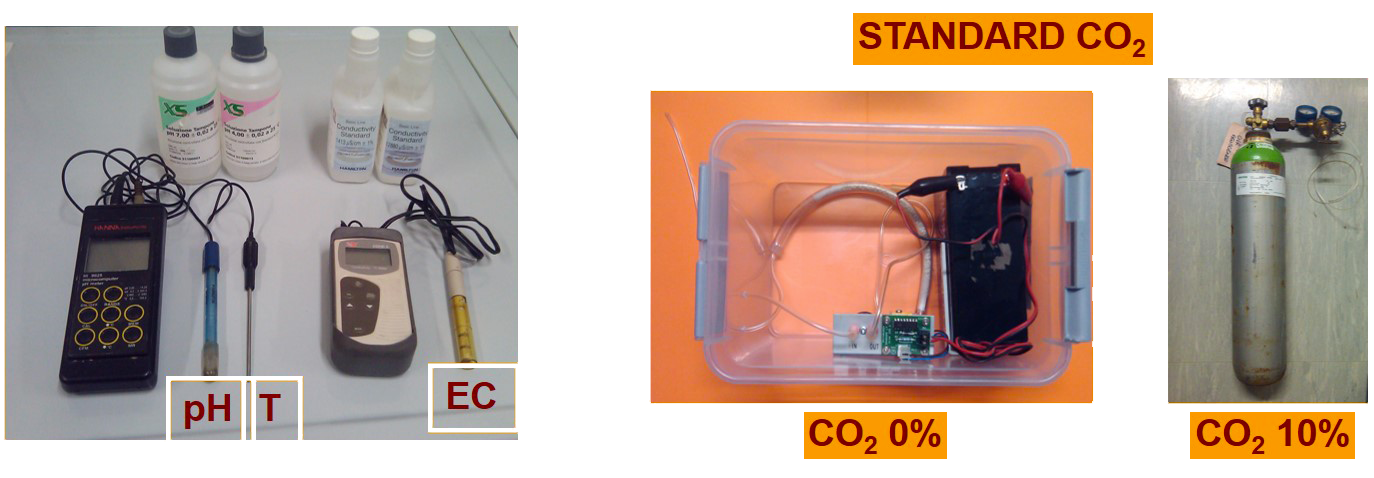
Isotopical determinations (δ18O, δD, δ13C, δ34S) are occasionally made to have additional information on the residence time in the aquifer, on the feeding areas of the deep circuits, or about the origin of sulfates and dissolved CO2 in the waters.
Data series were analyzed with statistical methods through the statistical software STATISTICA 7.0 (Statsoft Inc., 2005), to highlight possible anomalous variations related to seismic activity. The first operation consists in the removal of outliers recorded during the maintenance operations, and during the interruption of the water inflow into the cells, generally due to pump failures and/or electrical blackouts. Each month, during the maintenance operations, the water inflow in the cells is interrupted for about one hour. Due to the sampling step of 5 minutes, 12 abnormal measurements are recorded each month. To eliminate these outliers, the data were filtered with the technique of the moving median smoothing, which allows for the replacement of each element of the series with the median of 2N+1 surrounding elements, where 2N+1=25 points is the width of the smoothing "window" used in our case (Box and Jenkins, 1976; Velleman and Hoaglin, 1981). The data acquired during the interruption of the flow in the cells are directly eliminated from the signal processing (Fig. 6).
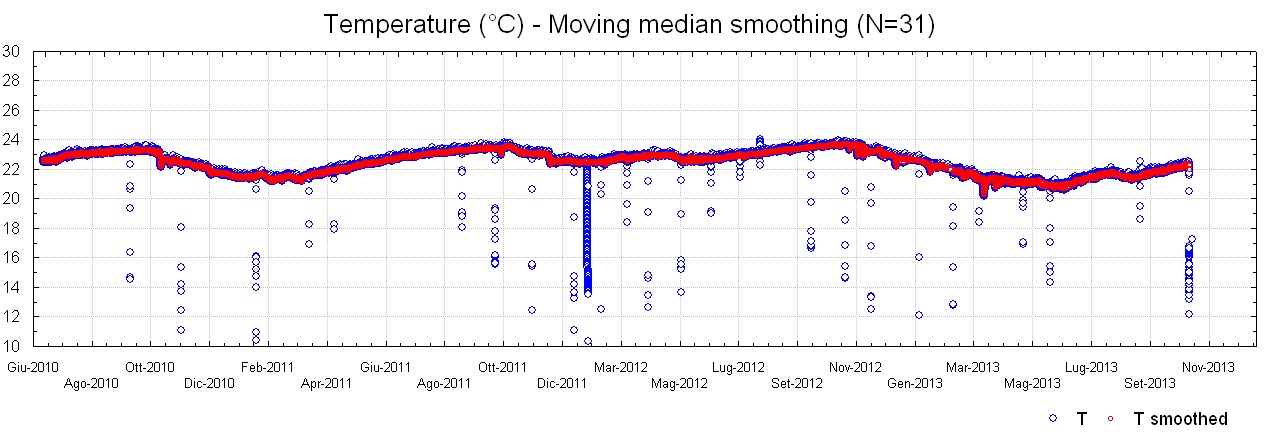
After ten years of activity, the following conclusions can be drawn about the continuous geochemical monitoring of the GNT:
- the monitoring station has the capability to precisely and accurately detect small variations of the measured parameters;
- an accurate definition of the natural geochemical baseline of the monitored manifestations has been achieved through the acquisition of very long time series of several hundreds of thousands data for each station.
- the huge amount of data acquired since late 2002 have provided fundamental information about fluid circulation paths, water and dissolved gases origin, mixing processes, and water-rock interactions at depth;
- In each test site, geochemical data have been integrated with geological, structural and hydrogeological information to decipher the mechanisms that control the movement of underground waters and to develop updated hydrogeological models. This has allowed to distinguish with reasonable certainty those that can be defined like "signal anomalies.".